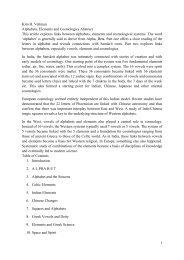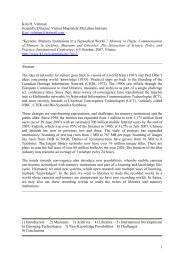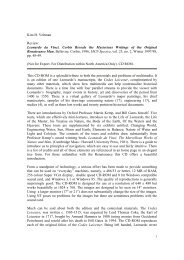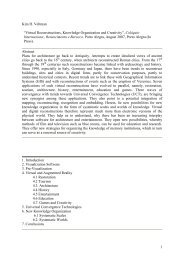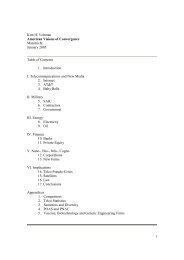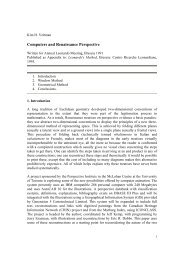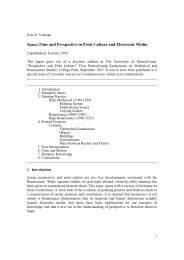1986 Perspective, Anamorphosis And Vision
1986 Perspective, Anamorphosis And Vision
1986 Perspective, Anamorphosis And Vision
You also want an ePaper? Increase the reach of your titles
YUMPU automatically turns print PDFs into web optimized ePapers that Google loves.
11. Conclusions<br />
Erwin Panofsky 64 , influenced by the Neo-Kantians, assumed that there must be<br />
necessary connections between the world view of a given culture, its theory of vision<br />
and its theory of projection and representation. He believed that a finite world view<br />
had con-strained the Greeks to develop both a curvilinear theory of vision and<br />
practice of representation. He was not clear whether this curvilinear method should be<br />
spherical or cylindrical. He assumed, in any case, that it would result in the fishbonelike<br />
alignment of vanishing points along a central axis (fig. 48). Neither a spherical<br />
nor a cylindrical projection plane placed in front of a model room with squares will<br />
produce such an effect (figs. 49-51). Panofsky also believed that the development of<br />
an infinite world view had led Brunelleschi to discover linear perspective which<br />
introduced a concept of uniform space in painting.<br />
This new method of representation theoretically precluded alternatives involving<br />
cylindrical, curvilinear or angular projection methods. Moreover, linear perspective<br />
theoretically required a revision in the Euclidean theory of vision in order that<br />
apparent size be based on projected size (on planes) rather than on visual angles.<br />
The historical evidence points to a considerably more complex situation. With respect<br />
to Antiquity there is evidence of at least three methods of representation: 1. optical<br />
adjustments methods, 2. what Panofsky termed fish-bone perspective and 3. those<br />
Pompeian examples that approximate the effects of linear perspective and which John<br />
White 65 believes are examples of linear perspective.<br />
If one accepts John White's claim it makes nonsense of Panofsky's framework. For<br />
linear perspective would then be a manifestation of both a finite an infinite world<br />
view. If one rejects White's claim then the Pompeian examples are a variant of the<br />
fish-bone or axial perspective. This method does not link with a cylindrical or<br />
spherical projection method. The method appears instead to have been empirical and to<br />
have been used both by the Romans and artists in the fourteenth and fifteenth centuries.<br />
With respect of optical adjustments methods we have evidence of their being used in<br />
sculpture, stage scenery and wall painting in Antiquity. Although these ancient methods<br />
were based on optical theory we have no concrete evidence of their having been linked<br />
with any systematic cylindrical or spherical projection method. We have evidence,<br />
however, that optical adjustments methods remained in use throughout the Renaissance,<br />
indeed throughout the seventeenth and eighteenth centuries (e.g. figs. 38-40) and that they<br />
were sometimes linked with cylindrical projection methods during this period.<br />
In short, Panofsky assumed that a given culture should have one world view, one theory<br />
of vision, one method of projection and one method of representation and that all these<br />
should be linked. In Antiquity this was certainly not the case, and such methods as there<br />
were recurred in the Renaissance.<br />
With respect to the Renaissance, Brunelleschi's experiments introduced neither a sudden<br />
revolution in spatial theory nor in painting practice. Change was gradual. As late as the<br />
1470's Piero was denying the inverse size distance law of linear perspective. Leonardo in<br />
the 1490's was the first to state it and demonstrate it experimentally. Even so the full<br />
implications of perspective's law of planes (cf. fig. 36) were not understood by Leonardo<br />
or even his sixteenth century followers.<br />
19



